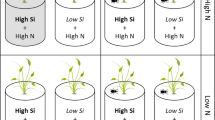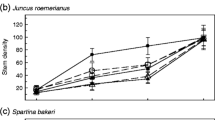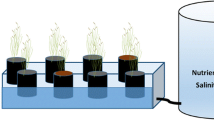Abstract
Nitrogen (N) and Silicon (Si) availability can affect the vigor and resiliency of plant communities. The effects of N on plant growth has been investigated in multiple species and is understood to promote growth. Though it is generally understood that Si aids in plant functions such as stem strength enhancement and herbivory defense, the role Si has not been explored in many wetland plant species. Tidal wetland plants are often subjected to high wind and wave energy, which can cause breakage or collapse of stems. This body of research investigated the combined effects of Si and N regimes to reduce the occurrence of stem collapse through its influence on stem strength. We investigated the effects of Si and N concentration on the growth, morphology, and physiology of Schoenoplectus acutus and Schoenoplectus californicus, two species of macrophytes that are commonly used in freshwater tidal restoration plantings. Individuals of each species were grown hydroponically in four different nutrient combinations (low Si and low N, low Si and high N, high Si and low N, and high Si and high N). Results indicated that increased N concentrations promoted aboveground biomass production, whereas increased Si concentration enhanced stem strength and decreased the likelihood of stem collapse and herbivory. Plants receiving a high Si and low N nutrient combination exhibited the most robust stems. Our findings emphasize the importance of Si, as well as N, in Schoenoplectus spp. growth and highlight the potential applications for these nutrients in enhancing tidal marsh management.






Similar content being viewed by others
References
Adatia MH, Besford RT (1986) The effects of silicon on cucumber plants grown in recirculating nutrient solution. Ann Bot 58:343–351
Ahmed M, Asif M (2012) Goyal A (2012) Silicon the non-essential beneficial plant nutrient to enhanced drought tolerance in wheat. In Tech, Rijeka
Albert DA, Cox DT, Lemein T, Yoon HD (2013) Characterization of Schoenoplectus pungens in a Great Lakes Coastal Wetland and a Pacific Northwestern Estuary. Wetlands 33(3):445–458
Alvarez J, Datnoff LE (2001) The economic potential of silicon for integrated management and sustainable rice production. Crop Prot 20:43–48
Ary TS, Lujan M Jr (1992) Crystalline silica primer: staff branch of industrial minerals. U.S. Department of the Interior, U.S. Bureau of Mines, Washington
Audebert A (2012) Root system sstructure. 2nd Global Rice Phenotyping Network Workshop. IRRI 22–24, November 2012
Bertness MD, Ellison AM (1987) Determinants of pattern in a New England salt marsh plant community. Ecol Monogr 57:129–147
Billings WD (1945) The plant associations of the Carson Desert region, western Nevada. Butl Univ Bot Stud 7:89–123
Boesch DF, Brinsfield RB, Magnien RE (2001) Chesapeake Bay eutrophication. J Environ Qual 30:303–320
Brisson J, Chazarenc F (2009) Maximizing pollutant removal in constructed wetlands: should we pay more attention to macrophyte species selection? Sci Total Environ 407(13):3923–3930
Brix H (1987) Treatment of wastewater in the rhizosphere of wetland plants-the root-zone method. Water Sci Tech 19:107–118
Colwell RK, Fuentes ER (1975) Experimental studies of the niche. Annu Rev Ecol Syst 6:281–310
Crook MJ, Ennos AR (1995) The effect of nitrogen and growth regulators on stem and root characteristics associated with lodging in two cultivars of winter wheat. J Exp Bot 46:931–938
Datnoff LE, Snyder GH, Korndörfer GH (2001) Silicon in agriculture, vol 8. Elsevier Publishing, Amsterdam
de Lange PJ, Gardner RO, Champion PD, Tanner CC (1998) Schoenoplectus californicus in New Zealand. NZ J Bot 36:319–327
Deegan L, Johnson DS, Warren RS, Peterson BJ, Fleeger JW, Fagherazzi S, Wollheim WM (2012) Coastal eutrophication as a driver of salt marsh loss. Nature 490:388–392
Dietzel M (2002) Interaction of polysilicic and monosilicic acid with mineral surfaces. Water-Rock Interact 40:207–235
Elser JJ, Bracken MES, Cleland EE, Gruner DS, Harpole WS, Hillebrand H, Ngai JT, Seabloom EW, Shurin JB, Smith JE (2007) Global analysis of nitrogen and phosphorus limitation of primary producers in freshwater, marine, and terrestrial ecosystems. Ecol Lett. https://doi.org/10.1111/j.1461-0248.2007.01113.x
Epstein E (1994) The anomaly of silicon in plant biology. Proc Natl Acad Sci USA 91:11–17
Epstein E (1999) Silicon. Annu Rev Plant Physiol 50:641–664
Gao X, Zou C, Wang L, Zhang F (2005) Silicon improves water use efficiency in maize plants. J Plant Nutr 27:1457–1470
Garnier J, Beusen A, Thieu V, Billen G, Bouwman L (2010) N:P: Si nutrient export ratios and ecological consequences in coastal seas evaluated by the ICEP approach. Global Biogeochem Cycles. https://doi.org/10.1029/2009GB003583
Giurgiu RM, Morar GA, Dumitras A, Boanca P, Duda BM, Moldovan C (2014) Study regarding the suitability of cultivating medicinal plants in hydroponic systems in controlled environment. Res J Agric Sci 46(2):84–92
Griffin KL, Thomas RB, Strain BR (1993) Effects of nitrogen supply and elevated carbon dioxide on construction cost in leaves of Pinus taeda (L.) seedlings. Oecologia 95:575–580
Grime JP (1977) Evidence for the existence of three primary strategies in plants and its relevance to ecological and evolutionary theory. Am Nat 11:1169–1194
Grime JP (1979) Plant strategies and vegetation processes. Wiley, New York
Hackney CT, Cahoon LB, Preziosi C, Norris A (2002) Silicon is the link between tidal marshes and estuarine fisheries: a new paradigm. Concepts Controv Tidal Marsh Ecol 543–552
Hester MW, Willis JM, Sloey TM (2015) Field assessment of environmental factors constraining the development and expansion of Schoenoplectus californicus marsh at a California tidal freshwater restoration site. Wetl Ecol Manage 24(1):33–44
Hoag CJ (1998) Wetland plant fact sheet. Interagency riparian/wetland project. USDA-NRCS Plant Materials Center, Aberdeen
Hodge A (2004) The plastic plant: root response to heterogeneous supplies of nutrients. New Phytol 162:9–24
Hooper DU, Johnson L (1999) Nitrogen limitation in dryland ecosystems: responses to geographical and temporal variation in precipitation. Biogeochemistry 46:247
Horiguchi T (1988) Mechanism of manganese toxicity and tolerance of plants: IV. Effects of silicon on alleviation of manganese toxicity of rice plants. Soil Sci Plant Nutr 34:65–73
Houser C, Trimble S, Morales B (2015) Influence of blade flexibility on the drag coefficient of aquatic vegetation. Estuaries Coasts 38:569–577
Inanaga S, Okasaka A, Tanaka S (1995) Does Silicon exist in association with organic compounds in rice plant? Soil Sci Plant Nutr 41:111–117
Jackson RB, Caldwell MM (1989) The timing and degree of root proliferation in fertile-soil microsites for three cold-desert perennials. Oecologia 81:149–153
Jones LHP, Handreck KA (1967) Silica in soils, plants, and animals. Adv Agron 19:107–149
Kamenidou S, Cavins TJ (2008) Silicon supplements affect horticultural traits of greenhouse-produced ornamental sunflowers. Hortic Sci 43:236–239
Keddy PA (1990) Competitive hierarchies and centrifugal organization in plant communities. In: Grace JB, Tilman D (eds) Perspectives on plant competition. Academic Press, Inc., San Diego
Kenk G, Fischer H (1988) Evidence from nitrogen fertilization in the forests of Germany. Environ Pollut 54:199–218
Kimble RB, Ensminger A (1959) Duck food habits in Southwestern Louisiana marshes following a hurricane. J Wildl Manag 23:453–455
Körndorfer GH, Lepsch I (2001) Effect of silicon on plant growth and crop yield. Stud Plant Sci 8:133–147
Lambers H, Chapin FS, Pons TL (2008) Plant physiological ecology, 2nd edn. Springer Science & Business Media, LLC, New York
LeBauer DS, Treseder KK (2008) Nitrogen limitation of net primary productivity in terrestrial ecosystems is globally distributed. Ecology 89:371–379
Liebig JV (1855) Principles of Agricultural chemistry with special reference to the late researches made in England. 17–34. Reprinted in: Cycles of essential elements. Benchmark papers in Ecology Vol.1, L.R. Pomeroy. 1974. Dowden, Hutchinson & Ross Inc., Stroudsburg, Pennsylvania, 11–28
López-Bucio J, Cruz-Ramırez A, Herrera-Estrella L (2003) The role of nutrient availability in regulating root architecture. Curr Opin Plant Biol 6:280–287
Ma JF, Takahashi E (2002) Soil, fertilizer, and plant silicon research in Japan. Elsevier, Amsterdam
Ma JF, Miyake Y, Takahaski E (2001) Silicon as a beneficial element for crop plants. In: Datnoff LE, Snyder GH, Korndorfer GH (eds) Silicon in agriculture. Elsevier, Amsterdam
Maire V, Gross N, da Silveira Pontes L, Picon-Cochard C, Soussana JF (2009) Trade-off between root nitrogen acquisition and shoot nitrogen utilization across 13 co-occurring pasture grass species. Funct Ecol 23(4):668–679
Makino A, Mae T, Ohira K (1988) Differences between wheat and rice in the enzymic properties of ribulose-1, 5-bisphosphate carboxylase/oxygenase and the relationship to photosynthetic gas exchange. Planta 174:30–38
Markham JH, Zekveld C (2007) Nitrogen fixation makes biomass allocation to roots independent of soil nitrogen supply. Can J Bot 85:787–793
Massey FP, Hartley SE (2006) Experimental demonstration of the antiherbivory effects of silica in grasses: impacts on foliage digestibility and vole growth rates. Proc R Soc Biol Sci 273:2299–2304
Mengel K, Kirkby EA, Kosegarten H, Appel T (2001) Principles of Plant Nutrition. Springer Science & Business Media, New York
Menninger HM, Palmer MA (2006) Restoring ecological communities: from theory to practice. In: Foundation of restoration ecology. Island Press, Washington, DC, pp. 88–112
Mitani N, Ma JF (2005) Uptake system of silicon in different plant species. J Exp Bot 56:1255–1261
Neill C (1990) Effects of nutrients and water levels on species composition in prairie whitetop (Scolochloa festucacea) marshes. Can J Bot 68:1015–1020
Parry DW, Smithson F (1964) Types of opaline silica depositions in the leaves of British grasses. Ann Bot 28:169–185
Parsons M (2013) Pore Water Sampling—SESD Operating Procedure. U.S. Environmental Protection Agency Region 4, Science and Ecosystem Support Division. Athens, GA. SESDPROC-513-R2
Reinhardt DR, Miller RM (1990) Size classes of root diameter and mycorrhizal fungal colonization in tow temperate grassland communities. New Phytol 116:129–136
Reynolds OI, Keeping MG, Meyer JH (2009) Silicon-augmented resistance of plants to herbivorous insects: a review. Ann Appl Biol 155:171–186
Samuels AL, Glass ADM, Ehret DL, Menzies JG (1991) Mobility and deposition of silicon in cucumber plants. Plant Cell Environ 14:485–492
Savant NK, Datnoff LE, Snyder GH (1997) Depletion of plant-available silicon in soils: a possible cause of declining rice yields. Commun Soil Sci Plant Anal 28:1245–1252
Schneider CA, Rasband WS, Eliceiri KW (2012) NIH Image to ImajeJ: 25 years of image analysis. Nat Methods 9:671–675
Schubert S, Mengel K (1989) Important factors in nutrient availability: root morphology and physiology. J Plant Nutr Soil Sci 152:169–174
Shimoyama S (1958) Effect of calcium silicate application to rice plants on the alleviation of lodging and damage from strong gales. Studies in the improvement of the ultimate yields of crops by the application of silicate materials. Jpn Assoc Adv Sci 57–99
Sloey TM, Willis JM, Hester MW (2015) Hydrologic and edaphic constraints on Schoenoplectus acutus, Schoenoplectus californicus, and Typha latifolia in tidal marsh restoration. Restor Ecol 23:430–438
Sloey TM, Howard RJ, Hester MW (2016) Response of Schoenoplectus acutus and Schoenoplectus californicus at different life-history stages to hydrologic regime. Wetlands 36:37–46
Smith TM, Smith RL (2009) Elements of ecology, 7th edn. Peason Benjamin-Cummings Publishing Co., San Francisco
Struyf E, Conley DJ (2009) Silica: an essential nutrient in wetland biogeochemistry. Front Ecol Environ 7:88–94
Taiz L, Zeiger E (2010) Plant physiology, 5th edn. Sinauer Associates, Inc., Sunderland
Tamm C (1991) Nitrogen in terrestrial ecosystems: questions of productivity, vegetational changes, and ecosystem stability. Springer-Verlag, Heidelberg
Tanner CC (2001) Plants as ecosystem engineers in subsurface-flow treatment wetlands. Water Sci Technol 44:9–17
Turner ER (2010) Beneath the salt marsh canopy: loss of soil strength with increasing nutrient loads. 2011. Estuaries Coasts 34:1084–1093
Valiela I, Rietsma CS (1995) Disturbance of salt marsh vegetation by wrack mats in Great Sippewissett marsh. Oecologia 102:106–112
Vasey MC, Parker VT, Callaway JC, Herbert ER, Schille LM (2012) Tidal wetland vegetation in the San Francisco Bay-Delta Estuary. San Franc Estuary Watershed Sci 10:1–16
Vitousek PM, Howarth RW (1991) Nitrogen limitation on land and in the sea: how can it occur? Biogeochemistry 13:87–115
Wallace A (1989) Relationships among nitrogen, silicon, and heavy metal uptake by plants. Soil Sci 147:457–460
Wigand C, Comeleo R, McKinney R, Thursby G, Chintala M, Charpentier M (2013) Outline of a new approach to evaluate ecological integrity of salt marshes. Hum Ecol Risk Assess 5:1541–1554
Wisheu IC, Keddy PA (1992) Competition and Centrifugal organization of plant communities: theory and tests. J Veg Sci 3:147–156
Acknowledgements
We extend sincere thanks to the University of Louisiana at Lafayette Ecology Center and Andre Daugereaux for use and operation of the air boat. Greenhouse assistance was provided by members of the Coastal Plant Ecology Laboratory, Jonathan Willis, Erik Yando, Scott Jones, and Laura Hundy. Imaging was assisted by the UL Lafayette Microscopy Center. Dennis Albert and Dan Cox of Oregon State University provided assistance with stem strength analysis techniques. Finally, thanks to Rebecca Howard, Scott France, Paul Leberg, and Beth Middleton for review of this manuscript.
Author information
Authors and Affiliations
Corresponding author
Appendices
Appendix 1
See Table 2.
Appendix 2
See Table 3.
Appendix 3
See Table 4.
Appendix 4
See Table 5.
Rights and permissions
About this article
Cite this article
Sloey, T.M., Hester, M.W. Impact of nitrogen and importance of silicon on mechanical stem strength in Schoenoplectus acutus and Schoenoplectus californicus: applications for restoration. Wetlands Ecol Manage 26, 459–474 (2018). https://doi.org/10.1007/s11273-017-9586-3
Received:
Accepted:
Published:
Issue Date:
DOI: https://doi.org/10.1007/s11273-017-9586-3




